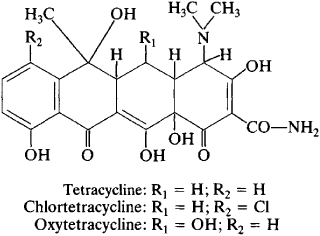tetracycline
[‚te·trə′sī‚klēn]Tetracycline
any of a group of natural and semisynthetic antibiotics of similar chemical structure and biological action. In terms of chemical structure, tetracyclines are a tetracyclic condensed system with various substituents.
The natural tetracyclines—oxytetracycline (terramycin), chlortetracycline (aureomycin), and tetracycline—were discovered and isolated in the 1940’s and 1950’s from the metabolic products of such actinomycetes as Actinomyces rimosus and A. aureofaciens. (In the non-Soviet literature, the genus Actinomyces is called Streptomyces.)

Preparations obtained by the chemical modification of natural tetracyclines, as well as semisynthetic derivatives of tetracycline, are also used in medicine. Examples of the first group are Reve-rin, morphocycline, and glycocycline; among the members of the second are methacycline hydrochloride (Rondomycin), doxycycline (Vibramycin), and minocycline.
Tetracyclines are broad-spectrum antibiotics. They inhibit the growth of gram-positive and gram-negative bacteria, spirochetes, leptospires, rickettsiae, mycoplasmas, several protozoans (amoe-bas and trichomonads), and large viruses of the psittacosis-lym-phogranuloma and trachoma groups. They are inactive or only slightly active against Proteus, Pseudomonas aeruginosa, Mycobacterium tuberculosis, and most fungi and small viruses. The bacteriostatic action of tetracyclines results from the repression of protein biosynthesis in the bacterial cell.
The development of resistance to one of the tetracyclines is accompanied by resistance to all other tetracyclines except minocycline. Preparations combining tetracyclines with antibiotics having a different mechanism of antimicrobial action, such as oleandomycin, are used to prevent the propagation of strains resistant to tetracycline.
Tetracyclines are used for the treatment of diseases of the respiratory organs and the gastrointestinal, urinary, and biliary tracts, as well as infections of the soft tissues, epidemic typhus, and other diseases caused by microorganisms sensitive to these drugs. Tetracyclines are effective in infections caused by microorganisms that are resistant to other antibiotics.
REFERENCES
Chernukh, A. M., and G. Ia. Kivman. Antibiotiki gruppy tetratsiklinov. Moscow, 1962.Barton, D. H. R. “Novye puti sinteza tetratsiklina.” Zhurnal Vses. khimicheskogo obshchestva im. D. I. Mendeleeva, 1971, vol. 16, no. 2.
Navashin, S. M., and I. P. Fomina. Spravochnik po antibiotikam, 3rd ed. Moscow, 1974.
Finland, M. “Twenty-fifth Anniversary of the Discovery of Aureomycin: The Place of the Tetracyclines in Antimicrobial Therapy.” Clinical Pharmacology and Therapeutics, 1974, vol. 15, no. 1.
L. E. GOL’DBERG